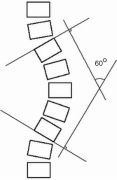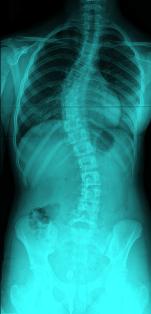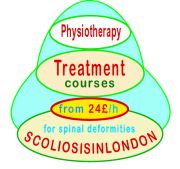|
HEALTHY SPINE CENTRE - SCOLIOSIS INFORMATION
WHAT IS SCOLIOSIS OF THE SPINE?
scoliosis - abnormal curvature of the spine
poor posture and muscular weakness - exercise scoliosis
Scoliosis was first described by Hippocrates and the term "scoliosis" was first used by Galen. Historically, scoliosis was defined as a lateral or sideways curve in the spine. Now we know that scoliosis is a three dimensional deformity of the spine with lateral deviation as well as vertebral rotation. Scoliosis can affect both children and adults. In children it is a much more serious condition because it can rapidly progress as the child grows. Scoliosis can develop at any age. People with a family history of spinal deformity are at greater risk of developing scoliosis. If scoliosis is neglected, the curves might progress dramatically. What is more, improperly treated scoliosis may lead to disabilities, neurological disorders, permanent disabilities with circulatory and respiratory problems. Physical changes in the body posture can also cause Depression. Depression caused by scoliosis leads to further health problems. That is why early detection is essential!
Scoliosis may be either Structural or Functional. Structural deformities are characterized by permanent structural changes in the bone and are usually congenital. Structural or permanent changes may also result from mechanical dysfunction, ultimately leading to permanent degenerative changes that disrupt the normal contours and motions of the spine over time. With structural scoliosis, the vertebrae are rotated with the anterior body toward the convex side. This rotation causes the posterior ribs and posterior chest wall to be more prominent, or sunken in, on the concave side.
Functional deformities do not involve permanent bone changes and typically result from mechanical dysfunction due to poor posture, leg length discrepancy, joint inflammation, nerve root irritation, muscular imbalance, soft tissue shortening, or a combination of these. These conditions are marked by observable postural deformity and loss of spinal ROM (range of movement). A distinguishing factor of functional versus structural curvatures is that functional curvature disappears with forward flexion of the spine. Because of the muscular imbalances and compensatory changes created by these spinal curvatures, patients with scoliosis often complain of pain, muscular fatigue, and spasm in the postural muscles. It is important to recognize functional scoliosis in the physically active and to correct the mechanical dysfunction in order to prevent irreversible structural changes over time. 
SCOLIOSIS CLASSIFICATION:
Scoliosis is generally classified as Mild, Moderate or Severe.
Scoliosis is measured in degrees by a measurement known as a Cobb angle.
Any measurement under 10 degrees is not considered to be scoliosis.
- Mild scoliosis – if the Cobb angle is 10 degree to 24 degrees
- Moderate scoliosis – 25 – 50 degrees
- Severe scoliosis – over 50 degrees
COBB ANGLE MEASUREMENT:
Cobb Angle is measured by identifying the most tilted vertebra at the top of the curve and the most tilted vertebra at the bottom of the curve. A line is drawn from the upper edge of the vertebra at the top and the second line from the lower edge of the vertebra at the bottom of the curve. Where the lines cross is the Cobb angle. There is a standard error of 5 degrees, therefore changes below 5 degrees are not significant. The Cobb angle is the universal standard to diagnose scoliosis and to assess whether a curvature has stabilized or is getting worse.
THE TRUNK CAN BE DIVIDED INTO THREE SEGMENTS:
- Cervical spine with shoulder girdle
- Thoracic spine with rib cage
- Lumbar spine with pelvis
In a healthy person, these three segments can represented by rectangles. These segments are stacked vertically on top of each other. In the case of scoliosis, these three segments are wedge shape and are shifted against each other.
-Pelvis and shoulder girdle are shifted to the same direction,
-Rib cage is shifted to the opposite side.
-The more these blocks shift against each other, the more they deviate from a vertical line, the more they deviate also in the transverse plane.
In scoliosis, the muscles on the convex side are overstretch and they should be tighten. On the concave side of the spine the muscles are shorter and they should to be lengthen. Very often muscle imbalance causes pain.
CAUSES OF SCOLIOSIS:
Causes of scoliosis include:
1) Neuromuscularscoliosis - due to a condition
that affects the nerves and muscles of the back,
such as cerebral palsy or muscular dystrophy.
2) Metabolicscoliosis - is associated with disorders
of metabolism, this includes osteoporosis which is
a loss of bone density.
3) Trauma - scoliosis can develop after an accident
that damaged the spine.
SIGNS AND SYMPTOMS OF SCOLIOSIS:
Symptoms of scoliosis include:
One shoulder is higher than the other
One hip is higher than the other
One shoulder blade protrudes from the back
The waist line is flat on one side and not flat on the other
Asymmetric size or location of breast in females
Head is not centered directly above the pelvis
Leaning of entire body to one side
Unequal distance between arms and body
Rib cages that are at different heights
Visible difference in look or texture of skin overlying the sides of the spine
Ribs are more prominent on one side
Rib prominence while the patient is bent over
Leg lenght discrepancy/inequality
IDIOPATHIC SCOLIOSIS:
Idiopathic scoliosis is the most common of all forms of lateral deviation of the spine. The deviation occurs during the growing years and can be divided into three categories.
1) Infantile < 3 years
2) Juvenile 3 - 9 years
3) Adolescent 10 years until the end of maturity ( 16 - 18 years )
These are classified according to the age at which the deformity is first noted. The aetiology of Idiopathic Scoliosis is still unknown.
MORE CONDITION:
BODY IMAGE, SCOLIOSIS AFFECTS GIRLS:
Scoliosis causes deformities such as: asymmetrical elevations of the shoulders and hips, rotations of shoulders girdle and pelvis girdle, prominence of a shoulder blade etc. Because of the deformities, the psychological effects of the condition can be acute, especially in young girls. They suffer from a negative view of their own body image, which, can lead to low self-esteem, affecting their confidence and ability to interact with other people. Girls try to cover their rib humps up and always worrying about what they can and can not wear. They experience emotional distress, including anxiety, fear and depression. Girls can have problem with intimate relationship.
Kyphosis is an excessive posterior curvature of the upper and midthoracic spine. The rounded contour of the upper thoracic spine is accentuated secondarily to congenital factors, compensatory changes, muscular imbalance, joint disease, compression fractures, osteoporosis in older adults, and Scheuermann’s disease in young persons.
Lordosis, the opposite of kyphosis, is an excessive anterior (forward) curvature of the lumbar spine. An increased lordotic curve may be congenital, but may also be acquired secondary to muscle imbalances such as weak abdominals, tight hip flexors, and tight back extensors that rotate the pelvis forward. Increased lumbar lordosis can result in low back pain because it increases musculature stress as well as placing stress on the posterior, non- weight bearing elements of the spine (facet joints).
Scheuermann’s disease is a growth disorder characterised by inflammation and osteochondritis of the thoracic vertebrae. This degenerative condition wedges or narrows the anterior vertebral body at three or more levels secondary to axial and flexion overload. An active condition may contraindicate sport participation and often increases pain with activity and forward flexion movements. Patients with a history of Scheuermann’s disease may complain of occasional pain, muscular fatigue, and spasm associated with the increased kyphosis.
*
About one third of the most severe hyperkyphosis cases
have vertebral fractures.
*
Early detection and proper diagnosis should lead to successful non surgical physiotherapeutic treatment of scoliosis disease!
treatment breathing exercises - the Katharina Schroth Method for adults and children |

scoliosis

Schroth Method
RISK FACTORS FOR SCOLIOSIS
1/SEX - mild curves affect boys and girls equally, but girls are 10 times more likely to have curves that can progress.
2/AGE - the younger the child when scoliosis appears, the bigger chance of progression.
3/GENETIC FACTORS - it is thought that scoliosis runs in families.
Children of women who have scoliosis should be screened for scoliosis regularly...
Do you suffer from:
scoliosis pain?
pins and needles?
Back pain?
or
Neck pain?
Early detection may lead to early diagnosis and treatment, which may stop the curve from getting worse.
A SMALL DEGREE
OF BOTH
Kyphotic and lordotic curvature is normal. Too much kyphotic curving causes round shoulders or hunched shoulders Scheuermann's desease
LORDOSIS
Your lower back has a natural inward curve. An excessive inward curve is called lordosis. Lordosis is a common cause of lower back pain.
CERVICAL LORDOSIS
Cervical Lordosis is when there is two much curve in the spinal column in the neck or cervical area.
LUMBAR LORDOSIS
Too much of a curve in the low back puts pressure on the entire back. This can lead to pain and poor movement.
Lumbar lordosis and pelvic inclination of asymptomatic adults
KYPHOSIS
kyphosis is used to describe the spinal curve that sometimes results in an abnormally rounded back hyperkyphosis.
When the backward curve in the upper spine is too great, the condition is called thoracic hyper-kyphosis, round back, Scheuermann's disease.
Severe scoliosis can interfere with breathing and lead to spondylosis.
Spondylosis is degenerative arthritis, osteoarthritis, of the spinal vertebra and related tissue. If severe, it may cause pressure on nerve roots with subsequent pain or paresthesia in the limbs
Healthy children
means
healthy adults
SPINE SCOLIOSIS CENTRE
Non surgical intensive physiotherapeutic treatment for scoliosis of the spine
Joanna Slup
london physiotherapist exercise scoliosis
scoliosis pain diagnosis |